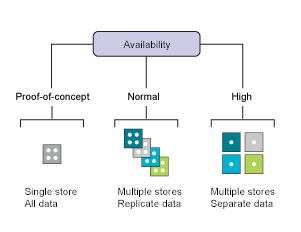Database topologies
The increasing complexity of network topology as you scale from a proof-of-concept environment using Derby to systems using vertical and horizontal cloning techniques.

You can install the database server on the same system as WebSphere Portal, or install the database server on a different system, also referred to as a remote system.
- Local
- Use a local database can make administering your environment easier.
- Remote
- Use a remote database can have performance benefits. When you are deploying in a large scale environment, you can dedicate a server specifically to your database. As more users are accessing the portal, the portal application becomes database intensive. Database activity can take up CPU utilization and disk I/O time. Separating the database from the server that the portal is running on increases capacity.
If you install the database server on a remote system, you might be required to install database client software on the WebSphere Portal system so that the portal can communicate with the remote database server.
- Proof-of-concept
- Use a local database can make administering your environment easier; however, this setup is best used as a proof-of-concept only.
- Normal
Use a remote database can have performance benefits. When you are deploying in a large scale environment, you can dedicate a server specifically to your database. As more users are accessing the portal, the portal application becomes database intensive. Database activity can take up CPU utilization and disk I/O time. Separating the database from the server that the portal is running on increases capacity.
If you install the database server on a remote system, you might be required to install database client software on the WebSphere Portal system so that the portal can communicate with the remote database server.
- High
WebSphere Portal data is organized into different database domains, with different availability requirements depending on how the production environment is set up. When multiple lines of production are involved and each line of production is implemented as a cluster of servers, sharing database domains ensures that the data is automatically synchronized across the lines of production.
Each database domain can be placed on a separate database, or each domain can be placed on a separate database server system for maximum performance.
Use a remote database can have performance benefits. When you are deploying in a large scale environment, you can dedicate a server specifically to your database. As more users are accessing the portal, the portal application becomes database intensive. Database activity can take up CPU utilization and disk I/O time. Separating the database from the server that the portal is running on increases capacity.
If you install the database server on a remote system, you might be required to install database client software on the WebSphere Portal system so that the portal can communicate with the remote database server.